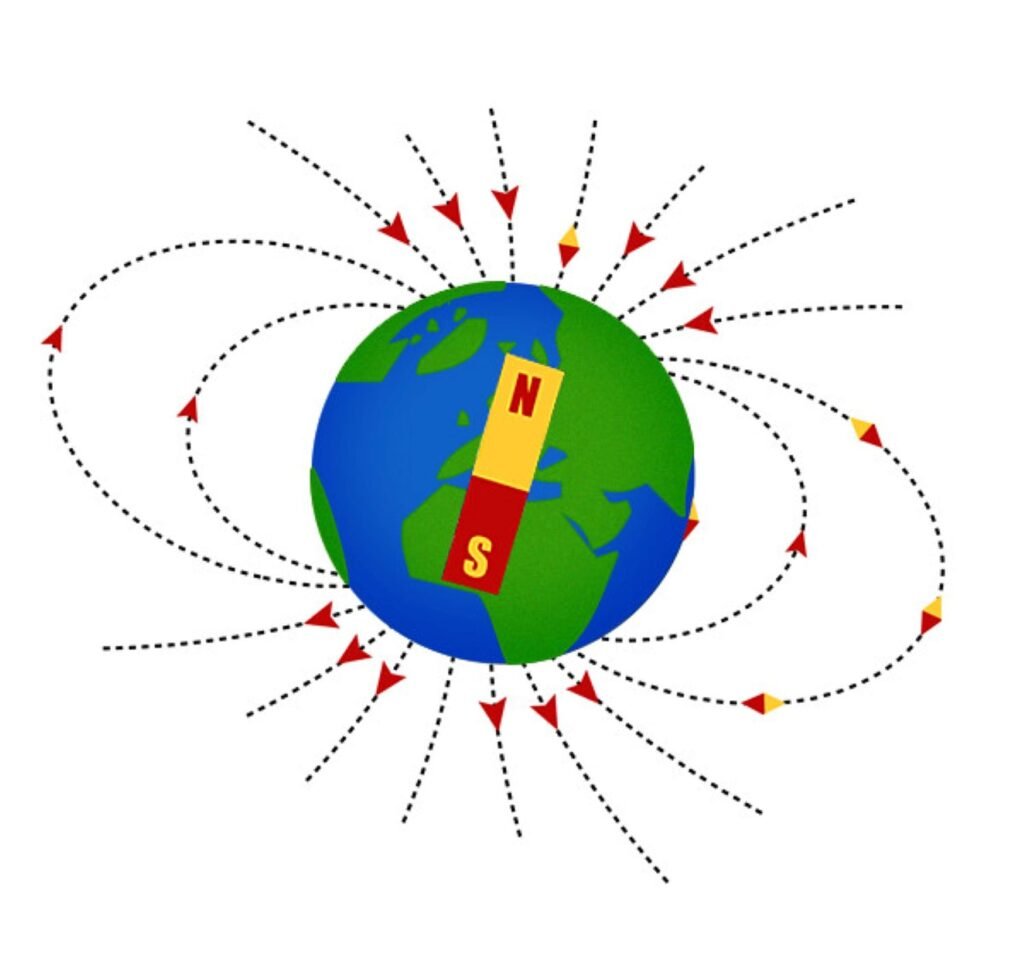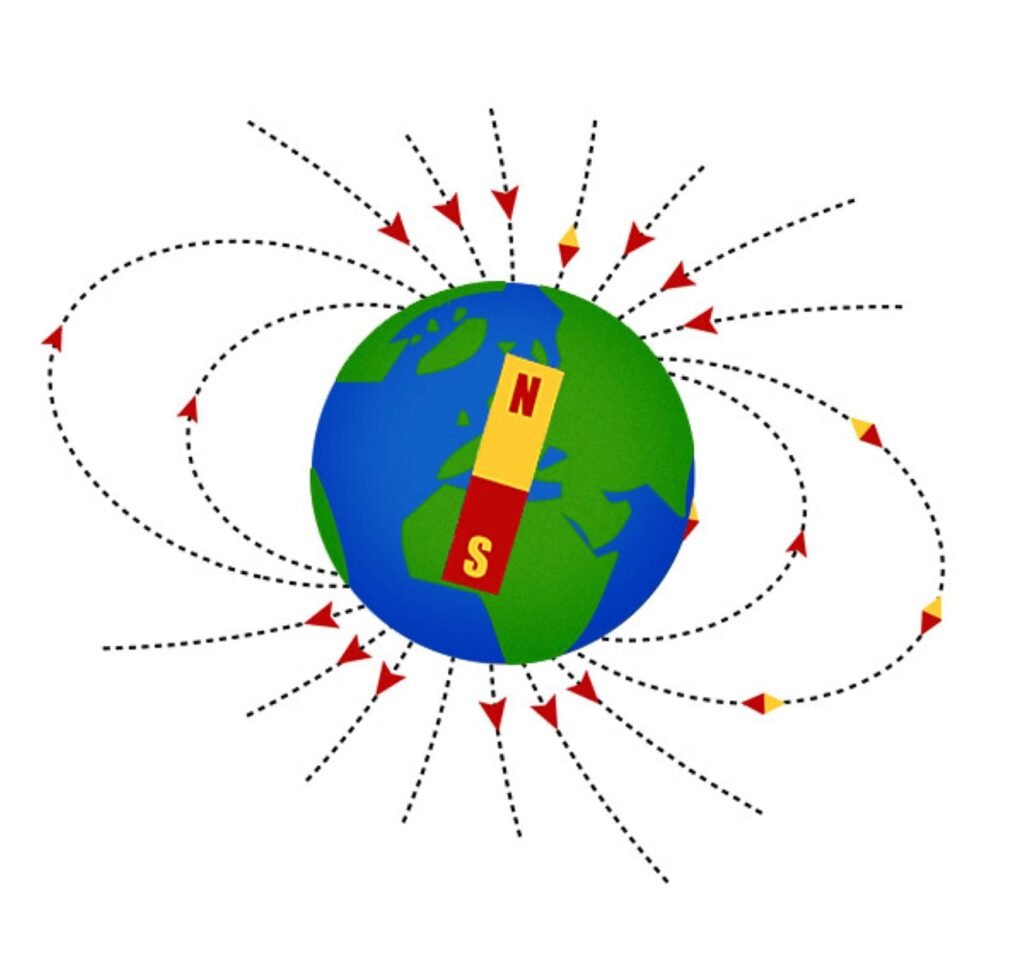Picture your compass suddenly pointing south instead of north. Imagine satellites failing across the globe while GPS systems scramble. This might sound like science fiction, yet recent discoveries from space-based monitoring systems reveal something extraordinary happening to our planet’s magnetic shield. Scientists are watching Earth’s magnetic field with unprecedented detail, uncovering dramatic changes that raise one compelling question: could we witness a complete magnetic reversal during our lifetimes?
The answer isn’t as simple as you might think. While our planet has experienced these magnetic flip-flops throughout its history, the timing remains unpredictable. Still, mounting evidence suggests we’re living through a period of unusual magnetic activity that deserves our attention.
What Actually Happens When Earth’s Magnetic Poles Reverse

A geomagnetic reversal is a change in the Earth’s dipole magnetic field such that the positions of magnetic north and magnetic south are interchanged. This phenomenon transforms our planet’s protective magnetic shield in ways that seem almost impossible to imagine.
Think of Earth’s magnetic field like an invisible force field stretching far into space. On average, Earth’s magnetic poles flip about every 450,000 years based on historical data. North becomes south and vice versa in a phenomenon called geomagnetic reversal. The process doesn’t happen overnight – it unfolds over thousands of years, creating a chaotic period where multiple magnetic poles can emerge in unexpected places.
During these transitions, the magnetic field doesn’t simply vanish. Instead, it weakens dramatically and becomes jumbled. During a pole reversal, the magnetic field weakens, but it doesn’t completely disappear. The magnetic field becomes jumbled, and multiple magnetic poles can emerge in unexpected places.
Earth’s Magnetic History Reveals Surprising Patterns

There have been at least 183 reversals over the last 83 million years (thus on average once every ~450,000 years). The latest, the Brunhes–Matuyama reversal, occurred 780,000 years ago. This record shows that magnetic reversals are anything but regular or predictable.
The geological record tells a fascinating story. Scientists can trace these ancient flip-flops by studying volcanic rocks and deep-sea sediments. When molten rock cools, it preserves a snapshot of the magnetic field’s direction at that moment in time. These natural recordings have revealed that there’s no pattern to them. There have been about 183 of them in the last 83 million years, leading us to the 450,000-year number. But the last one was 780,000 years ago, and some say that we’re overdue for the next one.
What makes this particularly intriguing is the irregular spacing between reversals. Some periods show rapid-fire reversals occurring every few thousand years, while others stretch for tens of millions of years without a single flip.
Current Warning Signs Point to Unusual Magnetic Activity

Modern satellites are detecting remarkable changes in Earth’s magnetic field right now. Recent observations, including the rapid movement of the North magnetic pole towards Siberia and a consistent decrease in field intensity, suggest that another reversal may be underway, potentially starting within 500 to 1 000 years.
In the past 200 years, Earth’s magnetic field has weakened about nine percent on a global average. Some people cite this as “evidence” a pole reversal is imminent, but scientists have no reason to believe so. However, the combination of weakening intensity and pole movement creates an intriguing picture.
The magnetic north pole’s behavior has been particularly dramatic. Over the past few decades, magnetic north’s movement has been unprecedented – it dramatically sped up, then in a more recent twist rapidly slowed – though scientists can’t explain the underlying cause behind the magnetic field’s unusual behavior. This erratic movement differs significantly from the steady drift observed in previous centuries.
The South Atlantic Anomaly Reveals Deep Changes

Perhaps the most striking evidence of magnetic field changes comes from a region scientists call the South Atlantic Anomaly. Using 11 years of magnetic field measurements from the European Space Agency’s Swarm satellite constellation, scientists have discovered that the weak region in Earth’s magnetic field over the South Atlantic – known as the South Atlantic Anomaly – has expanded significantly since 2014.
This growing weak spot behaves in unexpected ways. “The South Atlantic Anomaly is not just a single block,” says lead author Chris Finlay, Professor of Geomagnetism at the Technical University of Denmark. “It’s changing differently towards Africa than it is near South America. There’s something special happening in this region that is causing the field to weaken in a more intense way.”
The anomaly creates a zone where satellites experience higher radiation exposure because the weakened magnetic field allows more cosmic particles to penetrate closer to Earth’s surface. Recent observations and forecasts show that the region is expanding westward and continuing to weaken in intensity. Observational data from 2015-2020 found that the SAA has recently started to split from a single valley, or region of minimum field strength, into two cells.
Magnetic Excursions Offer Clues About Reversals

Not all magnetic changes result in complete reversals. Sometimes Earth experiences what scientists call magnetic excursions – temporary flips that last only a few centuries before returning to normal. The Laschamps event about 42,000 years ago. In an excursion, the field reverses in Earth’s outer core while its inner core remains unchanged.
These excursions provide crucial insights into how magnetic reversals might unfold. During the Laschamps event, which lasted several hundred years, the field weakened to only 5% of its normal strength. Earth’s magnetic fields deflect cosmic rays away from Earth, and at only 5% of its normal strength, the field lets in far more cosmic rays than usual.
The Laschamps event left clear signatures in ice cores and marine sediments, showing dramatically increased levels of cosmic ray particles. This evidence helps scientists understand what might happen during a future reversal.
Scientists Develop New Prediction Methods

In a groundbreaking study published on February 3, 2024, a team of scientists led by Daniil Tolmachev introduced a novel approach to predicting Earth’s magnetic field reversals. Titled “Predictability of Magnetic Field Reversals,” the research utilizes mathematical modeling to identify early warning signals of these geomagnetic phenomena, potentially offering a new paradigm in understanding and preparing for their consequences on technology and life on Earth.
Traditional approaches to studying magnetic reversals have focused on replicating conditions within Earth’s outer core. Their approach differs from traditional models by not striving to replicate the exact conditions within Earth’s outer core but instead identifying fundamental dynamical behaviors indicative of reversals. Through this methodology, the team has discovered patterns in magnetic and hydrodynamic harmonics that could serve as precursors to polarity switches, offering a predictive insight into when these reversals might occur.
This breakthrough represents a significant step forward in magnetic field science. Rather than waiting for reversals to begin, scientists might soon be able to identify warning signs decades or centuries in advance.
Technology Faces Unprecedented Vulnerability

Modern civilization depends heavily on technologies that didn’t exist during previous magnetic reversals. A flip would disrupt radio communication and scramble navigation systems. Orbiting satellites would be at risk, as a weakened magnetic field would offer less protection against space weather. While life on Earth has weathered multiple magnetic reversals over more than 100 million years, “we’ve never experienced a reversal when modern technology was present,” experts warn.
The potential impacts extend beyond simple navigation problems. Space weather can have important consequences for our lives, such as interference with radio communication, GPS systems, electric power grids, the operation and orientation of satellites, oil and gas drilling, and even air travel as high altitude pilots and astronauts can be subjected to enhanced levels of radiation.
Satellites represent particularly vulnerable targets. Particle radiation in the SAA can knock out onboard computers and interfere with the data collection of satellites that pass through it. The SAA creates no visible impacts on daily life on the surface, and its weakening magnetic intensity is still within the bounds of what scientists consider normal variation. However, a full reversal would create similar conditions globally.
The Timeline Question: How Fast Could It Happen

No one knows exactly when the next pole reversal may occur, but scientists know they don’t happen overnight: they take place over hundreds to thousands of years. This extended timeline offers both reassurance and concern – reassurance because it means gradual adaptation is possible, but concern because the changes could begin within our lifetimes.
Scientists have estimated that this polar flip, which can take thousands of years to complete, happens on average about every 450,000 years, though the time between flips has varied greatly – from 5,000 years to as much as 50 million years. The signs that precede such flips are also not well understood, making them difficult to predict.
Some experts suggest we might already be witnessing the early stages. This acceleration could indicate the beginning of a field reversal, but scientists really can’t tell with less than 200 years of data. The relatively short period of detailed magnetic field observations makes predictions particularly challenging.
Climate and Environmental Impacts Remain Uncertain

While magnetic reversals don’t directly cause climate change, they can influence Earth’s atmosphere in subtle ways. While there is some evidence of regional climate changes during the Laschamps event timeframe, ice cores from Antarctica and Greenland don’t show any major changes. Moreover, when viewed within the context of climate variability during the last ice age, any changes in climate observed at Earth’s surface were subtle. Bottom line: There’s no evidence that Earth’s climate has been significantly impacted by the last three magnetic field excursions.
However, the weakening of Earth’s magnetic shield does allow more cosmic radiation to reach the atmosphere. As the field weakened to only 5 percent of its current strength the reversal process allowed a surpluss of cosmic rays to pass into Earth’s atmosphere. Ice and marine sediment preserve isotopic signatures of this higher-than-normal solar bombardment, with levels of beryllium-10 isotopes doubling during the Laschamps event. These altered atoms are formed when cosmic rays react with our atmosphere, ionizing the air and frying the ozone layer.
The long-term environmental consequences remain an area of active research, with some scientists speculating about potential connections to past extinction events.
Life on Earth Adapts But Faces New Challenges

Plant and animal fossils from the period of the last major pole reversal don’t show any big changes. Deep ocean sediment samples indicate glacial activity was stable. In fact, geologic and fossil records from previous reversals show nothing remarkable, such as doomsday events or major extinctions.
Still, some species might face significant challenges during a reversal. During a polar flip, animals that migrate using the magnetic field to find their way, such as whales, butterflies, sea turtles and many species of migratory birds, could be affected by the changing magnetic landscape. These animals have evolved sophisticated magnetic navigation systems that might struggle during periods of magnetic chaos.
A reversal usually takes a few thousand years, but during this time the magnetosphere’s orientation may shift and expose more of the Earth to cosmic radiation. These events may change the concentration of ozone in the atmosphere. Such changes could have cascading effects on ecosystems worldwide.
Preparing for an Uncertain Future

The possibility of experiencing a magnetic reversal within human timescales raises important questions about preparation and adaptation. “It would certainly be an interesting time for engineers to adapt our technology to, but hopefully one they’d have a slow, centuries-long build up to, rather than any sudden change.”
Aviation industries are already considering potential impacts. While there would be some temporary disruptions – such as recalibrating navigation equipment, updating charts and monitoring radiation levels – the overall impact on aviation would likely be manageable. With the right preparations and technological solutions in place, aviation would continue to operate safely, even during a magnetic pole reversal.
Scientists continue monitoring Earth’s magnetic field with unprecedented precision through satellite missions like Swarm. This ongoing surveillance provides the data needed to understand whether current changes represent normal fluctuations or the beginning of something more dramatic.
Conclusion: Living with Magnetic Uncertainty

The question of whether Earth’s magnetic field could flip during our lifetime remains tantalizingly unanswered. While the geological record shows that reversals are inevitable over long timescales, predicting exactly when the next one will occur proves incredibly challenging.
Current evidence presents a mixed picture. The rapid movement of magnetic north, the expanding South Atlantic Anomaly, and the overall weakening of the magnetic field all suggest unusual activity. Yet these changes might represent normal variations rather than precursors to a full reversal.
Perhaps the most remarkable aspect of this scientific puzzle is how it highlights our planet’s dynamic nature. Earth’s magnetic field isn’t a static feature – it’s a constantly evolving system driven by the churning motions of molten iron deep beneath our feet. As we develop better tools to monitor and understand these changes, we gain deeper insights into the complex processes that shape our world.
Whether or not we witness a magnetic reversal in our lifetimes, the ongoing changes in Earth’s magnetic field remind us that we live on a dynamic planet where extraordinary events remain possible. What do you think about the possibility of experiencing such a dramatic planetary change? The answer might be closer than we imagine.

Jan loves Wildlife and Animals and is one of the founders of Animals Around The Globe. He holds an MSc in Finance & Economics and is a passionate PADI Open Water Diver. His favorite animals are Mountain Gorillas, Tigers, and Great White Sharks. He lived in South Africa, Germany, the USA, Ireland, Italy, China, and Australia. Before AATG, Jan worked for Google, Axel Springer, BMW and others.




